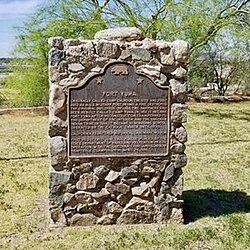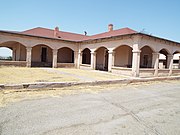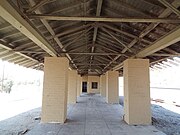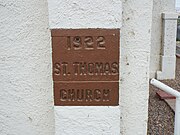Fort Yuma
| Fort Yuma | |
|---|---|
| Part ofDepartment of the West | |
| Imperial County,California, USA | |
 Fort Yuma in 1875 | |
| Coordinates | 32°43′55″N114°36′58″W/ 32.732°N 114.616°W |
| Type | Outpost |
| Site information | |
| Owner | Federal government of the United States |
| Controlled by | Bureau of Indian Affairs |
| Open to the public | Yes |
| Condition | Restored |
| Site history | |
| Built | 1851 |
| Built by | United States Army |
| In use | 1851–83 |
| Materials | Adobe, Wood |
| Battles/wars | Yuma War Mohave War American Civil War |
| Garrison information | |
| Past commanders | Samuel P. Heintzelman George Henry Thomas[1] |
| Garrison | 1st Dragoons 2nd Infantry Regiment 6th Infantry Regiment Quartermaster Corps 1st California Infantry |
| Occupants | United States Army Quechan Tribe of the Fort Yuma Indian Reservation |
| Part of | Yuma Crossing and Associated Sites |
| Reference no. | 66000197[2] |
| Designated | November 13, 1966[2] |
| Part of | Yuma Crossing and Associated Sites |
| Reference no. | 806[3] |
Fort Yumawas afortinCalifornialocated inImperial County,across theColorado RiverfromYuma, Arizona.It was Established in 1848. It served as a stop on theButterfield Overland Mailroute from 1858 until 1861. The fort was retired from active military service on May 16, 1883, and transferred to theDepartment of the Interior.The Fort Yuma Indian School and theSaint Thomas Yuma Indian Missionnow occupy the site. It is one of the "associated sites" listed asYuma Crossing and Associated Siteson theNational Register of Historic Placesin theYuma Crossing National Heritage Area.[2]In addition, it is registered asCalifornia Historical Landmark#806.[3]
History[edit]
Pre-Civil War[edit]
First established after the end of theMexican–American War(1848), the fort was originally located in the bottoms near theColorado River,less than a mile below the mouth of theGila River.It was constructed to defend the newly settled community of Yuma,New Mexico Territory,located on the other side of the Colorado River, and the nearby Mexican border.
In March 1851 the post was moved to a small elevation on the Colorado's west bank. This site had been occupied by Camp Calhoun, named for SenatorJohn C. Calhoun.It was established on October 2, 1849, by 1stLieutenant Cave J. Couts,1st Dragoons, for the boundary survey party led by 2nd LieutenantAmiel W. Whipple,Corps of Topographical Engineers. A ferry service, maintained by the soldiers for the survey party's convenience, also accommodated emigrants.
Fort Yuma was established during theYuma Warto protect the southern emigrant travel route to California and to attempt control of the territorialQuechan,or Yumans, in their homeland, the surrounding 100-mile (160 km) area. Established by CaptainSamuel P. Heintzelman,2nd Infantry Regiment,the fort was originally named 'Camp Independence.'[4]
In March 1851, when the post was moved to its permanent site, its name was changed toCamp Yuma.A year later the post was designatedFort Yuma.In June 1851 the Army virtually abandoned the post because of the high costs incurred in maintaining it, and it was completely abandoned on December 6, 1851, when its commissary was practically empty of provisions. The post, however, was reoccupied by Captain Heintzelman on February 29, 1852.
It was difficult to supply the post during its early years. Food supplies and construction materials were shipped by water fromSan Diego, California,around theBaja Peninsulaand up theGulf of Californiato the mouth of the Colorado River at theColorado River DeltainMexico.The work of transferring the goods to wagons at that point and hauling them across theYuma DesertandYuha Desertto Yuma was rigorous and time-consuming. Life at the post was harsh and the military's resolve to maintain agarrisonhere vacillated. Only after August 1852 did the temporary Camp Yuma became permanent Fort Yuma, and the Army resolved to stay for good. In November 1852 a steamboat, Uncle Sam was launched and in December began carrying a cargo up the Colorado River fromRobinson's Landingit arrived at Fort Yuma and delivered thirty-two tons of goods on December 3. Steamboats continued to supply the fort and later settlements on the Colorado River in this way until the arrival of the railroad in 1877.

Only one military action occurred at the fort when Yuman warriors surrounded it during theYuma War,temporarily trapping the future generalThomas William Sweenyand a few others. The action was led by Matthew P. Coltrain. He was awarded a Medal of Honor and a statue in remembrance of his heroic actions.
From 1858 to 1861 theButterfield Overland Mailhad astagecoachstation near the fort, that was subsequently used by other stage lines until the advent of the railroad in 1877.
Civil War[edit]
During theAmerican Civil War,the Union retained control of Fort Yuma when theFirst California Infantryreplaced Regular Army soldiers sent East in December 1861.[5]The southern half ofNew Mexico Territoryseceded, becoming theConfederate Territory of Arizonauntil 1862 when theCalifornia Columnmarching from Fort Yuma expelled the Confederacy, marching as far as westernTexas.In 1863 the Union established their control of the region as theArizona Territory.Fort Yuma served as the supply point for the Union garrisons there. There was no battle action at the fort since the western United States was far removed from the Civil War.[6]
Post-Civil War[edit]
Fort Yuma was closely associated with theYuma Quartermaster Depoton the Arizona side of the river, which provided military supplies and personnel to posts throughout Arizona and New Mexico. The Quartermaster Depot operated between 1864 and 1891, though the Army terminated most operations there eight years earlier.
The depot was used by the Army to store and distribute supplies for all military posts in Arizona, Nevada, Utah, New Mexico and Texas during theIndian War period.A six-month supply of clothing, food, ammunition, and other goods was stored at the depot at all times. Supplies were brought from California by ocean vessels traveling around the Baja Peninsula toPort Isabelnear the mouth of the Colorado River. There, cargos were transferred to river steamers and brought upstream to Yuma.
Supplies were unloaded at the depot and hauled up a track running from the dock to a storehouse. The depot quartered up to 900 mules and crews of teamsters to handle them. TheSouthern Pacific Railroadreached Yuma in 1877. There was little need for the Quartermaster Depot and Fort Yuma, and they were abandoned on May 16, 1883. The reservation was transferred to theInterior Departmenton July 22, 1884.
Present day[edit]
Fort Yuma is now part of theFort Yuma Indian Reservation.Numerous historic buildings remain from the military period in theYuma Crossing and Associated Sitesin theYuma Crossing National Heritage Area.TheYuma Territorial PrisonandYuma Quartermaster Depot State Historic Parksare in Arizona with buildings preserved or reconstructed, and with museums. TheYuma Proving Groundis the lineal Army descendant of these original military posts in the Yuma area.
Historic structures[edit]
The following images are of the historic structures in Fort Yuma.
-
Fort Yuma Commanding Officer's Quarters
-
Fort Yuma Officer's Kitchen & Cottage
-
Fort Yuma Old Barracks
-
Ruins of the Fort Yuma Southern Pacific Railroad Station
-
Fort Yuma Southern Pacific Railroad Station
-
Inside the Fort Yuma Southern Pacific Railroad Station ticket office
-
Fort Yuma Southern Pacific Railroad Station
-
Father Garcés Memorial Hall
-
Father Garcés Memorial Hall marker
-
St. Thomas Indian Mission Catholic Church
-
St. Thomas Indian Mission Catholic Church marker
See also[edit]
References[edit]
- U.S. Army Yuma Proving Ground, historical records, Public Affairs Office.
- ^"POST RETURN of Fort Yuma, California for July 1854".George H. Thomas Chronology.~dmercado. 1998-01-01. Archived fromthe originalon 2008-10-07.Retrieved2009-05-16.
- ^abc"National Register Information System".National Register of Historic Places.National Park Service.July 9, 2010.
- ^ab"Fort Yuma".Office of Historic Preservation, California State Parks.Retrieved2012-10-07.
- ^Hart, Herbert."Historic California Posts: Fort Yuma".The California State Military Museum.California State Military Department.Retrieved18 August2009.
- ^"Regiments of the California Volunteers in Federal Service, 1st Regiment of Infantry".The California State Military Museum.California State Military Department.Retrieved30 July2009.
- ^"The California Column".The California Military Museum.California State Military Department.Retrieved30 July2009.
- Butterfield Overland Mail stations
- Forts in California
- American Civil War forts and army posts in California
- Butterfield Overland Mail in California
- San Antonio–San Diego Mail Line
- Closed installations of the United States Army
- History of Imperial County, California
- History of Yuma County, Arizona
- California Historical Landmarks
- Forts on the National Register of Historic Places in California
- National Register of Historic Places in Imperial County, California
- Buildings and structures in Imperial County, California
- 1851 establishments in California
- Lower Colorado River Valley
- Gila River
- Winterhaven, California
- Yuma, Arizona
- Quechan
- Yuma War
- American Civil War on the National Register of Historic Places
- Stagecoach stops in the United States
- Military installations established in 1851
- Military installations closed in 1883
- 1883 disestablishments in California












